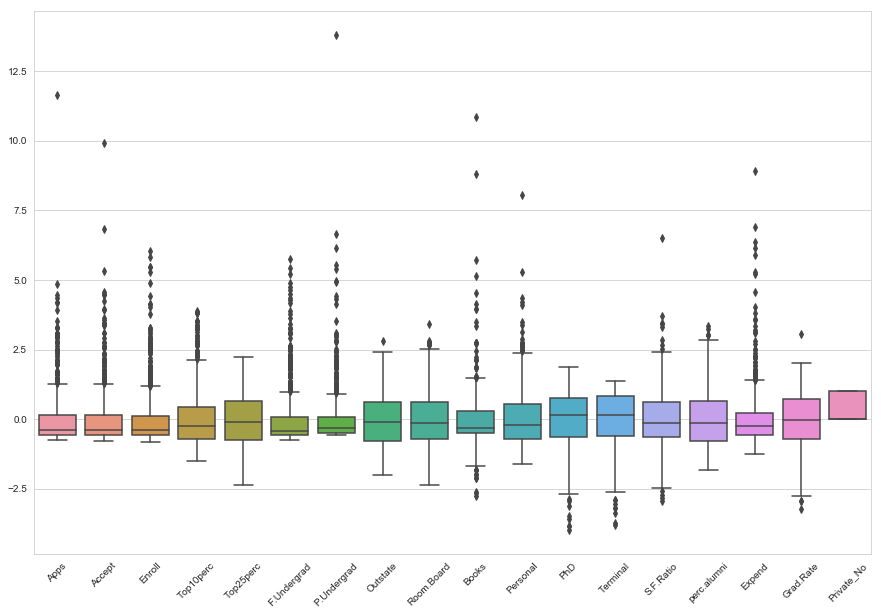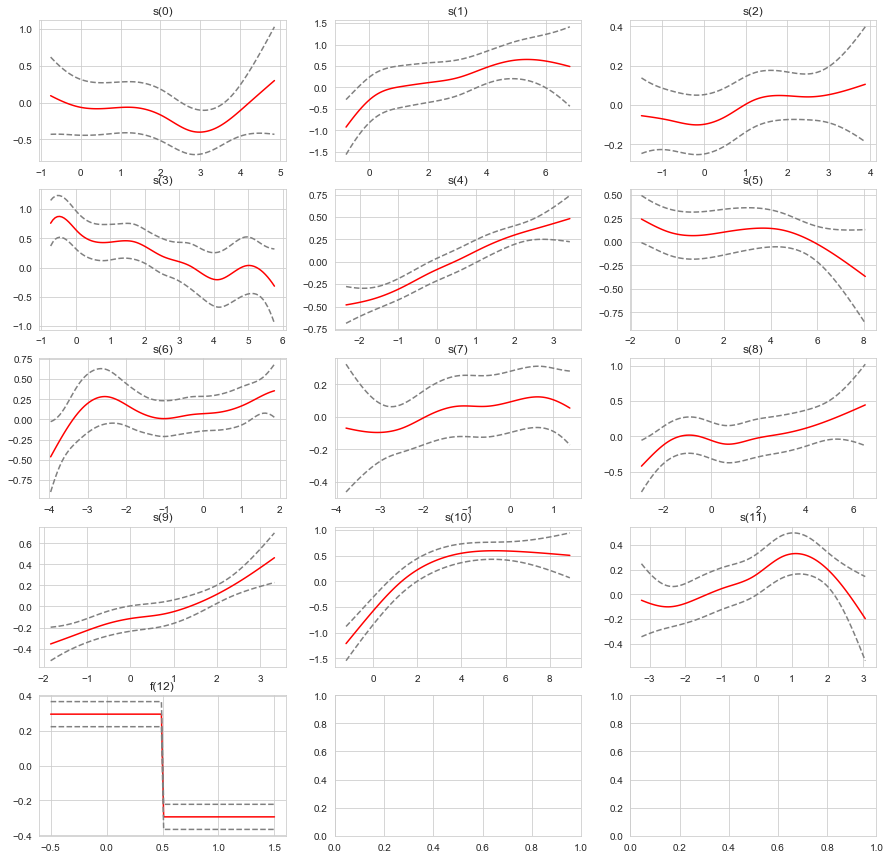islr notes and exercises from An Introduction to Statistical Learning
7. Moving Beyond Linearity
Exercise 10: Predicting Outstate in College dataset with FSS and GAM
Preparing the data
A description of the dataset can be found here
%matplotlib inline
import numpy as np
import pandas as pd
import seaborn as sns; sns.set_style('whitegrid')
import matplotlib.pyplot as plt
college = pd.read_csv('../../datasets/College.csv')
college = college.rename({'Unnamed: 0': 'Name'}, axis=1)
college.head()
| Name | Private | Apps | Accept | Enroll | Top10perc | Top25perc | F.Undergrad | P.Undergrad | Outstate | Room.Board | Books | Personal | PhD | Terminal | S.F.Ratio | perc.alumni | Expend | Grad.Rate | |
|---|---|---|---|---|---|---|---|---|---|---|---|---|---|---|---|---|---|---|---|
| 0 | Abilene Christian University | Yes | 1660 | 1232 | 721 | 23 | 52 | 2885 | 537 | 7440 | 3300 | 450 | 2200 | 70 | 78 | 18.1 | 12 | 7041 | 60 |
| 1 | Adelphi University | Yes | 2186 | 1924 | 512 | 16 | 29 | 2683 | 1227 | 12280 | 6450 | 750 | 1500 | 29 | 30 | 12.2 | 16 | 10527 | 56 |
| 2 | Adrian College | Yes | 1428 | 1097 | 336 | 22 | 50 | 1036 | 99 | 11250 | 3750 | 400 | 1165 | 53 | 66 | 12.9 | 30 | 8735 | 54 |
| 3 | Agnes Scott College | Yes | 417 | 349 | 137 | 60 | 89 | 510 | 63 | 12960 | 5450 | 450 | 875 | 92 | 97 | 7.7 | 37 | 19016 | 59 |
| 4 | Alaska Pacific University | Yes | 193 | 146 | 55 | 16 | 44 | 249 | 869 | 7560 | 4120 | 800 | 1500 | 76 | 72 | 11.9 | 2 | 10922 | 15 |
college.info()
<class 'pandas.core.frame.DataFrame'>
RangeIndex: 777 entries, 0 to 776
Data columns (total 19 columns):
Name 777 non-null object
Private 777 non-null object
Apps 777 non-null int64
Accept 777 non-null int64
Enroll 777 non-null int64
Top10perc 777 non-null int64
Top25perc 777 non-null int64
F.Undergrad 777 non-null int64
P.Undergrad 777 non-null int64
Outstate 777 non-null int64
Room.Board 777 non-null int64
Books 777 non-null int64
Personal 777 non-null int64
PhD 777 non-null int64
Terminal 777 non-null int64
S.F.Ratio 777 non-null float64
perc.alumni 777 non-null int64
Expend 777 non-null int64
Grad.Rate 777 non-null int64
dtypes: float64(1), int64(16), object(2)
memory usage: 115.4+ KB
# dummy variables for categorical variables
data = pd.concat([college['Name'],
pd.get_dummies(college.drop(columns=['Name']))],
axis=1)
# drop redundant variable
data = data.drop(columns=['Private_Yes'])
# standardize
cols = data.columns.drop(['Name', 'Private_No'])
df = data[cols]
data.loc[:, list(cols)] = (df - df.mean())/df.std()
data.head()
| Name | Apps | Accept | Enroll | Top10perc | Top25perc | F.Undergrad | P.Undergrad | Outstate | Room.Board | Books | Personal | PhD | Terminal | S.F.Ratio | perc.alumni | Expend | Grad.Rate | Private_No | |
|---|---|---|---|---|---|---|---|---|---|---|---|---|---|---|---|---|---|---|---|
| 0 | Abilene Christian University | -0.346659 | -0.320999 | -0.063468 | -0.258416 | -0.191704 | -0.168008 | -0.209072 | -0.745875 | -0.964284 | -0.601924 | 1.269228 | -0.162923 | -0.115654 | 1.013123 | -0.867016 | -0.501587 | -0.318047 | 0 |
| 1 | Adelphi University | -0.210748 | -0.038678 | -0.288398 | -0.655234 | -1.353040 | -0.209653 | 0.244150 | 0.457202 | 1.907979 | 1.215097 | 0.235363 | -2.673923 | -3.376001 | -0.477397 | -0.544222 | 0.166003 | -0.550907 | 0 |
| 2 | Adrian College | -0.406604 | -0.376076 | -0.477814 | -0.315105 | -0.292690 | -0.549212 | -0.496770 | 0.201175 | -0.553960 | -0.904761 | -0.259415 | -1.204069 | -0.930741 | -0.300556 | 0.585558 | -0.177176 | -0.667337 | 0 |
| 3 | Agnes Scott College | -0.667830 | -0.681243 | -0.691982 | 1.839046 | 1.676532 | -0.657656 | -0.520416 | 0.626229 | 0.996150 | -0.601924 | -0.687730 | 1.184443 | 1.174900 | -1.614235 | 1.150447 | 1.791697 | -0.376262 | 0 |
| 4 | Alaska Pacific University | -0.725709 | -0.764063 | -0.780232 | -0.655234 | -0.595647 | -0.711466 | 0.009000 | -0.716047 | -0.216584 | 1.517934 | 0.235363 | 0.204540 | -0.523198 | -0.553186 | -1.674001 | 0.241648 | -2.937721 | 0 |
plt.figure(figsize=(15, 10))
plt.xticks(rotation=45)
sns.boxplot(data=data)
<matplotlib.axes._subplots.AxesSubplot at 0x1a3308bd30>

a. Train-test split and Forward Stepwise Selection
After some experimentation, it was noted that the features selected were highly dependent on the train-test split so we decided to repeat the split many times and look at the most frequently occuring features
from sklearn.model_selection import train_test_split
from sklearn.linear_model import LinearRegression
from mlxtend.feature_selection import SequentialFeatureSelector
def is_present_in_fss():
# train test split default 0.25 test size
X, y = data.drop(columns=['Outstate', 'Name']), data['Outstate']
X_train, X_test, y_train, y_test = train_test_split(X, y)
# FSS for linear regression
linreg = LinearRegression()
fss = SequentialFeatureSelector(linreg, k_features='best', scoring='neg_mean_squared_error',
cv=7)
fss.fit(X_train, y_train)
# df with boolean features are present in fss best subset
return [col in fss.k_feature_names_ for col in data.columns]
def get_fss_results(n_runs=100):
return pd.DataFrame({i: is_present_in_fss() for i in range(1, n_runs + 1)},
index=data.columns).transpose()
fss_results = get_fss_results(n_runs=100)
from bokeh.io import show, output_notebook
from bokeh.plotting import figure
from bokeh.palettes import Greys
output_notebook()
<div class="bk-root">
<a href="https://bokeh.pydata.org" target="_blank" class="bk-logo bk-logo-small bk-logo-notebook"></a>
<span id="1281">Loading BokehJS ...</span>
</div>
from math import pi
res = fss_results.sum().sort_values(ascending=False)
x_range, counts = list(res.index), list(res)
p = figure(x_range=x_range, title="Frequency of features selected by FSS",
tools='hover')
p.vbar(x=x_range, top=counts, width=0.5, fill_color='grey', line_color='black')
p.xaxis.major_label_orientation = pi/4
show(p)
We note that Name and Outstate were never selected (this is by design) while Room.Board, perc.alumni, Expend, Grad.Rate and Private_No were always selected.
We reason that, in general, if a feature was selected approximately half the time, its selection by fss was statistically independent of the train-test split. These are the features for which the train test split provides no information.
Thankfully, there are no such features in our case. Our features partition naturally into those selected less than 40% of the time, and those selected greater than 60% of the time. We’ll take the latter for our final set of features
b. GAM for predicting Outstate from FSS features
from pygam import LinearGAM, s, f
# train test split on fss features
X, y = data[fss_results.sum()[fss_results.sum() > 60].index], data['Outstate']
X_train, X_test, y_train, y_test = train_test_split(X, y)
# terms for GAM
terms = s(0)
for i in range(1, X_fss.shape[1] - 1):
terms += si.
terms += f(12)
# optimize number of knots and smoothing penalty
n_splines = np.arange(10, 21)
lams = np.exp(np.random.rand(100, 13) * 6 - 3)
gam = LinearGAM(terms)
gam_search = gam.gridsearch(X_train.values, y_train.values, lam=lams, n_splines=n_splines)
100% (1100 of 1100) |####################| Elapsed Time: 0:02:21 Time: 0:02:21
gam_search.summary()
LinearGAM
=============================================== ==========================================================
Distribution: NormalDist Effective DoF: 51.7716
Link Function: IdentityLink Log Likelihood: -975.1374
Number of Samples: 582 AIC: 2055.8181
AICc: 2066.562
GCV: 0.2227
Scale: 0.1874
Pseudo R-Squared: 0.8302
==========================================================================================================
Feature Function Lambda Rank EDoF P > x Sig. Code
================================= ==================== ============ ============ ============ ============
s(0) [1.5147] 11 7.3 5.61e-02 .
s(1) [0.6188] 11 4.2 1.30e-02 *
s(2) [11.1] 11 3.9 2.85e-01
s(3) [0.0681] 11 6.0 1.60e-05 ***
s(4) [11.2738] 11 3.6 6.56e-11 ***
s(5) [5.4782] 11 3.5 1.75e-01
s(6) [0.1632] 11 6.7 4.05e-01
s(7) [4.7017] 11 3.7 4.87e-01
s(8) [1.3333] 11 4.0 2.39e-02 *
s(9) [18.3683] 11 2.7 1.25e-03 **
s(10) [13.242] 11 2.0 1.11e-16 ***
s(11) [3.5209] 11 3.3 1.87e-05 ***
f(12) [0.2243] 2 0.8 3.61e-14 ***
intercept 1 0.0 5.22e-01
==========================================================================================================
Significance codes: 0 '***' 0.001 '**' 0.01 '*' 0.05 '.' 0.1 ' ' 1
WARNING: Fitting splines and a linear function to a feature introduces a model identifiability problem
which can cause p-values to appear significant when they are not.
WARNING: p-values calculated in this manner behave correctly for un-penalized models or models with
known smoothing parameters, but when smoothing parameters have been estimated, the p-values
are typically lower than they should be, meaning that the tests reject the null too readily.
/anaconda3/envs/islr/lib/python3.7/site-packages/ipykernel_launcher.py:1: UserWarning: KNOWN BUG: p-values computed in this summary are likely much smaller than they should be.
Please do not make inferences based on these values!
Collaborate on a solution, and stay up to date at:
github.com/dswah/pyGAM/issues/163
"""Entry point for launching an IPython kernel.
fig, axs = plt.subplots(nrows=5, ncols=3, figsize=(15,15))
terms = gam_search.terms[:-1]
for i, term in enumerate(terms):
XX = gam_search.generate_X_grid(term=i)
pdep, confi = gam_search.partial_dependence(term=i, X=XX, width=0.95)
plt.subplot(5, 3, i + 1)
plt.plot(XX[:, term.feature], pdep, c='r')
plt.plot(XX[:, term.feature], confi, c='grey', ls='--')
plt.title(repr(term))
plt.show()

c. Evaluate on test set
from sklearn.metrics import mean_squared_error
# rmse on test data
np.sqrt(mean_squared_error(gam_search.predict(X_test), y_test))
0.5237308479472315
d. Significant features
# gam for significant features
terms = s(0) + s(1) + s(3) + s(4) + s(8) + s(9) + s(10) + s(11) + f(12)
# optimize number of knots and smoothing penalty
n_splines = np.arange(10, 21)
lams = np.exp(np.random.rand(100, 9) * 6 - 3)
gam2 = LinearGAM(terms)
gam2_search = gam.gridsearch(X_train.values, y_train.values, lam=lams, n_splines=n_splines)
100% (1100 of 1100) |####################| Elapsed Time: 0:01:24 Time: 0:01:24
gam2_search.summary()
LinearGAM
=============================================== ==========================================================
Distribution: NormalDist Effective DoF: 41.6337
Link Function: IdentityLink Log Likelihood: -1003.3785
Number of Samples: 582 AIC: 2092.0243
AICc: 2098.9351
GCV: 0.2145
Scale: 0.1871
Pseudo R-Squared: 0.8271
==========================================================================================================
Feature Function Lambda Rank EDoF P > x Sig. Code
================================= ==================== ============ ============ ============ ============
s(0) [2.1663] 12 8.2 4.57e-02 *
s(1) [0.1115] 12 5.3 8.11e-03 **
s(3) [0.0665] 12 6.7 5.58e-06 ***
s(4) [16.8656] 12 3.7 1.87e-11 ***
s(8) [9.4796] 12 3.6 9.01e-02 .
s(9) [12.1717] 12 3.6 5.82e-05 ***
s(10) [0.1146] 12 5.4 1.11e-16 ***
s(11) [3.2801] 12 4.3 1.05e-05 ***
f(12) [0.6573] 2 0.8 1.82e-13 ***
intercept 1 0.0 2.22e-02 *
==========================================================================================================
Significance codes: 0 '***' 0.001 '**' 0.01 '*' 0.05 '.' 0.1 ' ' 1
WARNING: Fitting splines and a linear function to a feature introduces a model identifiability problem
which can cause p-values to appear significant when they are not.
WARNING: p-values calculated in this manner behave correctly for un-penalized models or models with
known smoothing parameters, but when smoothing parameters have been estimated, the p-values
are typically lower than they should be, meaning that the tests reject the null too readily.
/anaconda3/envs/islr/lib/python3.7/site-packages/ipykernel_launcher.py:1: UserWarning: KNOWN BUG: p-values computed in this summary are likely much smaller than they should be.
Please do not make inferences based on these values!
Collaborate on a solution, and stay up to date at:
github.com/dswah/pyGAM/issues/163
"""Entry point for launching an IPython kernel.
np.sqrt(mean_squared_error(gam2_search.predict(X_test), y_test))
0.495656037843246